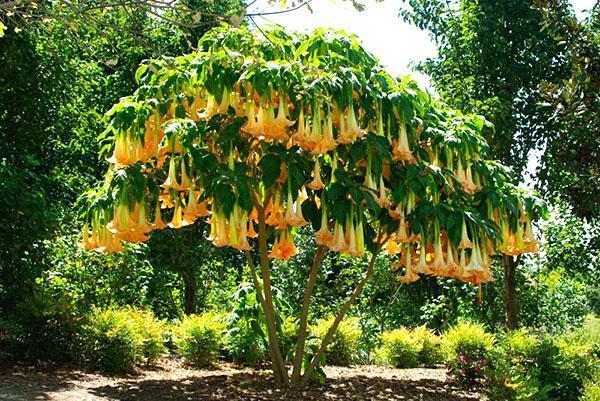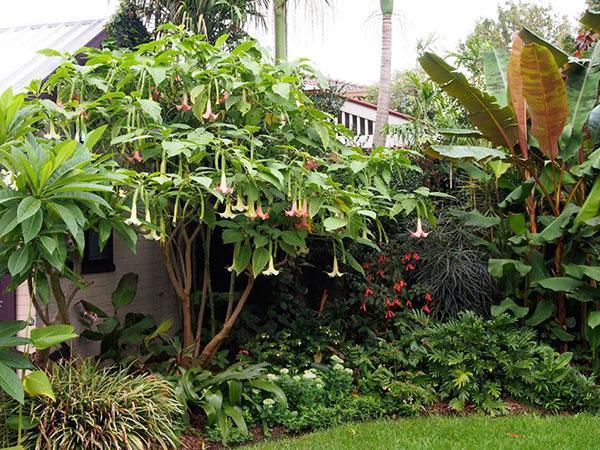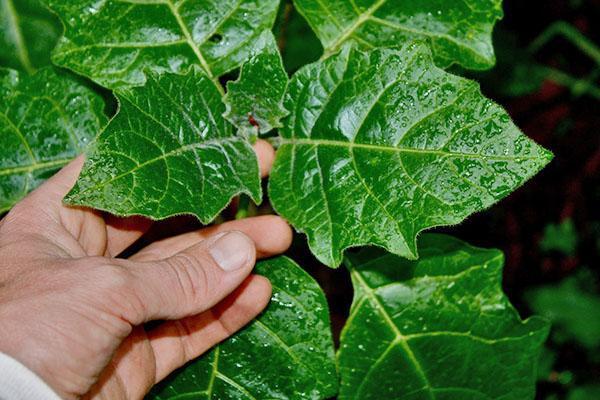The main types and memorable varieties of brugmansia
 It is difficult to imagine that a houseplant was covered with flowers 20 or 40 cm long. But there is such a culture - this is brugmansia, a photo of which at first glance arouses admiration and love of a florist.
It is difficult to imagine that a houseplant was covered with flowers 20 or 40 cm long. But there is such a culture - this is brugmansia, a photo of which at first glance arouses admiration and love of a florist.
The notable plants, reaching heights of 2 to 11 meters, belong to the Solanaceae family and are indigenous to the tropical regions of South America. In nature, brugmansii are perennial evergreen shrubs and trees. They retain the same form when grown in culture. However, garden brugmansia for the middle lane, due to its thermophilic character, is a pipe dream. Up to the subtropical zone, the plant can only be kept in a pot or taken out into fresh air for several summer months.
The size, low frost resistance, as well as the shape of the fruits distinguish brugmansia from dope, very similar to a tropical guest and not so long ago belonging to the same genus with this spectacular "American".

Features of brugmansia, photo and description of the plant
Brugmansia in nature, it is an evergreen tree or shrub with semi-lignified greenish-gray shoots. The trunk and skeletal branches are covered with a grayish bark, young shoots are green, drooping as they grow back. The crown of the plant consists of leaves sitting on long strong stalks.
 Brugmansia leaf plates, as in the photo, depending on the growing season and location, can have two different standard sizes:
Brugmansia leaf plates, as in the photo, depending on the growing season and location, can have two different standard sizes:
- large, reaching half a meter in length, built-up heart-shaped leaves with an even edge;
- relatively small leaves of the same shape, but only with a pronounced jagged edge.
 The main color of the foliage is green, but today lovers of ornamental crops can find variegated varieties of brugmansia, in which greens on the leaf plate are adjacent to white, silvery or yellowish border spots.
The main color of the foliage is green, but today lovers of ornamental crops can find variegated varieties of brugmansia, in which greens on the leaf plate are adjacent to white, silvery or yellowish border spots.
 The matt surface of the leaves is protected from the sun by the finest nap that creates a velvet effect, visible on young shoots, petioles and bracts.
The matt surface of the leaves is protected from the sun by the finest nap that creates a velvet effect, visible on young shoots, petioles and bracts.
So that the branched crown, sometimes reaching the height of a multi-storey building, can receive moisture and nutrition, grow and bloom, the plant acquires a powerful root system with a huge number of auxiliary roots.
 Due to the rapid development of the upper and underground parts, indoor brugmansia grown in pot, often requires transplanting and pruning rhizomes.
Due to the rapid development of the upper and underground parts, indoor brugmansia grown in pot, often requires transplanting and pruning rhizomes.
Flowers of brugmansia: photos and variety of shapes
But as amazing as the casting and roots of the plant are, the most striking thing about brugmasnia is the tubular flowers. Due to the unusual appearance of the corollas with a tube up to half a meter and a bell with a diameter of up to 20 centimeters, the plant received the popular name "Angel Trumpets".
 Luxurious brugmansia flowers, as in the photo, form on young green shoots and unfold incredibly quickly, emerging from the double perianth in a matter of hours, growing and expanding the intricately fused petals.
Luxurious brugmansia flowers, as in the photo, form on young green shoots and unfold incredibly quickly, emerging from the double perianth in a matter of hours, growing and expanding the intricately fused petals.
 The color of the flowers varies depending on the species and variety. The brugmansia palette includes white, pink, reds and coral, salmon, yellow and orange shades.
The color of the flowers varies depending on the species and variety. The brugmansia palette includes white, pink, reds and coral, salmon, yellow and orange shades.
Interestingly, the color saturation of pink brugmansia flowers depends on the weather. The warmer the air, the brighter the colors. Flowers appear more colorful and larger with regular feeding.
Thanks to breeders, brugmansia varieties with double and multi-tiered corollas appeared. Moreover, almost all varieties, especially at night, are very fragrant.
Types and varieties of brugmansia
Initially, the area where brugmansia grew united almost the entire tropical belt of South America. However, the beauty of the plant played a bad trick on him. Today, many species can no longer be found in nature. They exist only as cultural forms, but they are popular not only in their homeland, but throughout the world.
 But, having fallen into the hands of breeders, wild varieties of brugmansia have produced many spectacular varieties and hybrids with a brighter color than in nature, with bizarre corolla shapes and compact sizes. It was the selection that gave the room brugmansy. With the help of selection, scientists managed to obtain:
But, having fallen into the hands of breeders, wild varieties of brugmansia have produced many spectacular varieties and hybrids with a brighter color than in nature, with bizarre corolla shapes and compact sizes. It was the selection that gave the room brugmansy. With the help of selection, scientists managed to obtain:
- from 4-10 meter plants varieties growing up to 1.5-2.5 meters;
- variegated specimens not found in the tropics of the South American continent;
- hybrids with double, cascading and amazing split flowers.
 Interspecific hybrids have made it possible to obtain plants and flowers that previously could not have been dreamed of. But we must not forget that wild species were the basis for the work of botanists.
Interspecific hybrids have made it possible to obtain plants and flowers that previously could not have been dreamed of. But we must not forget that wild species were the basis for the work of botanists.
 Of these plants, the most famous is brugmansia arborea (B. arborea), first described by K. Linnaeus, but today it has completely disappeared from the wild. The original form grows up to 7 meters and at the time of flowering is covered with many creamy white or ivory tubular flowers about 15-17 cm long. They can be called the shortest in the genus Brugmansia, but they are no less beautiful and fragrant.
Of these plants, the most famous is brugmansia arborea (B. arborea), first described by K. Linnaeus, but today it has completely disappeared from the wild. The original form grows up to 7 meters and at the time of flowering is covered with many creamy white or ivory tubular flowers about 15-17 cm long. They can be called the shortest in the genus Brugmansia, but they are no less beautiful and fragrant.
 Varietal plants of tree brugmansia have not only a color close to white. At the same time, the trees are smaller than their wild-growing ancestors. Not uncommon - terry brugmansies, as in the photo, striking with exquisite shapes, reminiscent of old ball gowns.
Varietal plants of tree brugmansia have not only a color close to white. At the same time, the trees are smaller than their wild-growing ancestors. Not uncommon - terry brugmansies, as in the photo, striking with exquisite shapes, reminiscent of old ball gowns.
 A characteristic feature of Brugmansia snow-white (B. candida) is pure white in flowers and slightly greenish in buds. Thanks to crossing and selection, breeders managed to create Brugmansia varieties with an equally magnificent flowering, but already pink, cream and salmon corollas.
A characteristic feature of Brugmansia snow-white (B. candida) is pure white in flowers and slightly greenish in buds. Thanks to crossing and selection, breeders managed to create Brugmansia varieties with an equally magnificent flowering, but already pink, cream and salmon corollas.
 The varieties of pink brugmansia with multi-tiered corollas of the most delicate shades look incredibly elegant.
The varieties of pink brugmansia with multi-tiered corollas of the most delicate shades look incredibly elegant.
 Brugmansia golden, (B. aurea) in nature forms a tree up to 6 - 8 meters high. Brugmansia flowers, as in the photo, have a beautiful sunny color in all shades of yellow and orange.
Brugmansia golden, (B. aurea) in nature forms a tree up to 6 - 8 meters high. Brugmansia flowers, as in the photo, have a beautiful sunny color in all shades of yellow and orange.
 Yellow brugmansia looks incredibly impressive against the background of rich greenery. Terry varieties look especially advantageous and bright in the garden.
Yellow brugmansia looks incredibly impressive against the background of rich greenery. Terry varieties look especially advantageous and bright in the garden.
 The highest tree, up to 14 meters, forms a blood-red brugmansia (B. sanguinea). At the same time, the flowers that open on its branches are not too similar to the corollas of other varieties. Since the flowers are pollinated not by insects, but by hummingbirds, they do not have a bright aroma, but they amaze with rich colors: yellow, scarlet, carmine-red shades.
The highest tree, up to 14 meters, forms a blood-red brugmansia (B. sanguinea). At the same time, the flowers that open on its branches are not too similar to the corollas of other varieties. Since the flowers are pollinated not by insects, but by hummingbirds, they do not have a bright aroma, but they amaze with rich colors: yellow, scarlet, carmine-red shades.
 One of the largest flowers in the multi-colored or variegated brugmansia shown in the photo (B. versicolor) with corollas up to 40-50 cm. A bright flower of this species at the base of the tube has a light salad shade, which gradually becomes warmer downward, turns yellow, and towards the edge petals acquiring a bright orange or reddish color.
One of the largest flowers in the multi-colored or variegated brugmansia shown in the photo (B. versicolor) with corollas up to 40-50 cm. A bright flower of this species at the base of the tube has a light salad shade, which gradually becomes warmer downward, turns yellow, and towards the edge petals acquiring a bright orange or reddish color.
 Small trees or semi-lignified shrubs of aromatic Brugmansia (B. suaveolens) can be found in Brazil. Here, a branchy plant with large tubular flowers with white or creamy shades is also called "angel's tears". In nature, the height of brugmansia reaches 3-5 meters. Cultivars and hybrids are smaller, but they retain their marvelous aroma and exquisite corolla shape.
Small trees or semi-lignified shrubs of aromatic Brugmansia (B. suaveolens) can be found in Brazil. Here, a branchy plant with large tubular flowers with white or creamy shades is also called "angel's tears". In nature, the height of brugmansia reaches 3-5 meters. Cultivars and hybrids are smaller, but they retain their marvelous aroma and exquisite corolla shape.
 Local Amazonian tribes use the flowers and fruits shown in the brugmansia photo for healing and ritual purposes. At the same time, it was noticed that the aroma of the plant intensifies in the evening, luring a mass of insects to the white, pinkish or yellowish corollas.
Local Amazonian tribes use the flowers and fruits shown in the brugmansia photo for healing and ritual purposes. At the same time, it was noticed that the aroma of the plant intensifies in the evening, luring a mass of insects to the white, pinkish or yellowish corollas.
 Brugmansia volcanic (B.Vulcanicola) is an endemic native to the Colombian and Ecuadorian Andes. The plant is in the form of shrubs or trees up to 4 meters high.
Brugmansia volcanic (B.Vulcanicola) is an endemic native to the Colombian and Ecuadorian Andes. The plant is in the form of shrubs or trees up to 4 meters high.
 The delicate lavender or pink brugmansia Lavender Lady is an example of a cultivated variety of this plant. The fragrant flowers of this type of brugmansia are relatively small, they are 15 to 22 cm long and are colored in all shades of red, yellow and pink.
The delicate lavender or pink brugmansia Lavender Lady is an example of a cultivated variety of this plant. The fragrant flowers of this type of brugmansia are relatively small, they are 15 to 22 cm long and are colored in all shades of red, yellow and pink.
Some varieties of brugmansia
 The delicate yellow brugmansia of the Hazelnut Buttercup with terry whisks is reminiscent of fluffy whipped cream on a cake.
The delicate yellow brugmansia of the Hazelnut Buttercup with terry whisks is reminiscent of fluffy whipped cream on a cake.
 Audrey Lea, the original brugmansia, is much brighter than many other varieties. Its double corollas are painted in gentle coral tones, and the fused petals are intricately curled.
Audrey Lea, the original brugmansia, is much brighter than many other varieties. Its double corollas are painted in gentle coral tones, and the fused petals are intricately curled.
 Snowbank variegated brugmansia with white or cream-colored flowers is a plant for those who are not used to half measures. Everything is great here! Both large flowers of a simple form, and oval-pointed leaves with a white-yellow border and silvery spots on a green background.
Snowbank variegated brugmansia with white or cream-colored flowers is a plant for those who are not used to half measures. Everything is great here! Both large flowers of a simple form, and oval-pointed leaves with a white-yellow border and silvery spots on a green background.
 The rich orange-yellow shade of the flowers of the brugmansia Langenbuscher Garten not only attracts pollinating insects, but attracts the eyes of milestones around. This is a luxurious decoration for a garden or a spacious greenhouse.
The rich orange-yellow shade of the flowers of the brugmansia Langenbuscher Garten not only attracts pollinating insects, but attracts the eyes of milestones around. This is a luxurious decoration for a garden or a spacious greenhouse.
 The bright citrus variety of brugmansia Zitronenprinzessin was obtained by German breeders and fascinates not only with the joyful color of the corolla, but also with its two-layer shape.
The bright citrus variety of brugmansia Zitronenprinzessin was obtained by German breeders and fascinates not only with the joyful color of the corolla, but also with its two-layer shape.
 The splendor and lightness of the white corolla is difficult to argue with the Adretta brugmansia variety. The peculiarity of the plant is the long greenish tube of the flower and the triple layer of petals.
The splendor and lightness of the white corolla is difficult to argue with the Adretta brugmansia variety. The peculiarity of the plant is the long greenish tube of the flower and the triple layer of petals.
What are the opportunities and conditions for acquiring brugmansia seedlings (e-addresses of gardeners, shops, nurseries) Thank you!
We do not sell seedlings. Find a garden center in your area of residence. Brugmansia seedlings are best bought from local nurseries, which significantly increases the survival rate and reduces the risk of diseases of young plants.